Assessing Structural Damage after a Severe Wildfire: A Case Study
Abstract
:1. Introduction
- Opening security roads in the forest area, creating fire breaks, and limiting available fuel with prescribed burns and vegetation thinning;
- Monitoring and detecting the ignition of a fire in its early stages based on human surveillance and/or advanced detection and monitoring techniques, including satellite remote sensing, forest animals as biological sensors, image processing, etc. [1];
- Educating people in the community to avoid the initiation of fires when high winds are expected, especially in areas with combustible vegetation;
- Acquiring (by the government, local or national) all necessary equipment and personnel for fire suppression and having a plan of action to reduce fire spread and to direct people who are being evacuated from areas of danger.
2. Fires and Structures
3. Construction Materials Exposed to Fire
3.1. Behavior of Concrete in Fires
3.2. Behavior of Masonry in Fires
3.3. Behavior of Timber in Fires
3.4. Behavior of Steel in Fires
4. Case Study
4.1. Details of the Occurrence of the Wildfire
4.2. Observed Damage
4.2.1. Observed Damage of Reinforced Concrete Buildings
4.2.2. Observed Damage of Masonry Buildings
4.2.3. Observed Damage of Timber Structures
4.2.4. Observed Damage of Buildings with Steel Frames
5. Numerical Analysis
5.1. Numerical Model
5.2. Numerical Analysis Results and Discussion
6. Conclusions
- When the walls were exposed to extreme heat conditions and damage was observed, the highest thermal conductivity value recommended by Eurocode better represented the temperatures developed;
- The edges of the nonexposed faces of the wall panels were least affected by the extreme heat conditions;
- When wall openings were included in the analysis, they had to be considered together with their window frame in order to properly identify the temperatures that developed;
- The thickness of the wall panel played an important role in temperature distribution. The larger the thickness was, the lower the temperatures were that developed across the wall panel;
- The location of the window frame played an important role in thick masonry. When it was closely, the exposed face had a small effect on the temperatures that developed across the window and on the nonexposed face. The opposite occurred when the window frame was closer to the nonexposed face and the fire reached it. In the last case, the area around the window was affected the most.
Author Contributions
Funding
Conflicts of Interest
References
- Chowdary, V.; Gupta, M.K. Intelligent communication, control devices. In Advances in Intelligent Systems and Computing; Springer: Singapore, 2018; pp. 1111–1117. [Google Scholar]
- Dimitrakopoulos, A.; Gogi, C.; Stamatelos, G.; Mitsopoulos, I. Statistical analysis of the fire environment of large forest fires (> 1000 ha) in Greece. J. Environ. Stud. 2011, 20, 327–332. [Google Scholar]
- Xanthopoulos, G. Factors affecting the vulnerability of houses to wildland fire in the Mediterranean region. In Proceedings of the International Workshop Forest Fires in the Wildland-Urban Interface and Rural Areas in Europe, Athens, Greece, 15–16 May 2003. [Google Scholar]
- Buchanan, A.H.; Abu, A.K. Structural Design for Fire Safety, 2nd ed.; Wiley: Hoboken, NJ, USA, 2017. [Google Scholar]
- Porterie, B.; Consalvi, J.-L.; Loraud, J.-C.; Giroud, F.; Picard, C. Dynamics of wildland fires and their impact on structures. Combust. Flame 2007, 149, 314–328. [Google Scholar] [CrossRef]
- Bailey, C.G.; Moore, D.B. The behaviour of full-scale steel framed buildings subject to compartment fires. Struct. Eng. 1999, 7, 15–21. [Google Scholar]
- Lamont, S.; Lane, B.; Flint, G. Behavior of Structures in Fire and Real Design—A case Study. J. Fire Prot. Eng. 2006, 16, 5–35. [Google Scholar] [CrossRef]
- Foster, S.; Chladna, M.; Hsieh, C.; Burgess, I.; Plank, R. Thermal and structural behaviour of a full scale composite building subject to a severe compartment fire. Fire Saf. J. 2007, 42, 183–199. [Google Scholar] [CrossRef]
- Wald, F.; Simoes da Silva, L.; Moore, D.B.; Lennon, T.; Chladna, M.; Santiago, A.; Benes, M.; Borges, L. Experimental behaviour of a steel structure under natural fire. Fire Saf. J. 2006, 41, 509–522. [Google Scholar] [CrossRef]
- Butler, B.W. Characterization of convective heating in full scale wildland fires. In Proceedings of the VI International Conference on Forest Fire Research, Coimbra, Portugal, 15–18 November 2010; Viegas, D.X., Ed.; Miscellaneous Publication: Washington, DC, USA, 2010. [Google Scholar]
- ISO 834-1. Fire-Resistance Tests—Elements of Building Construction, Part 1: General Requirements; International Organization for Standardization: Geneva, Switzerland, 1999. [Google Scholar]
- Technical Chamber of Greece and National Technical University of Athens. Practical Guide for the Evaluation of Load Bearing Capacity and Structural Repairs on Small Concrete and Masonry Buildings after Fires; Technical Chamber of Greece and National Technical University of Athens: Athens, Greece, 2008. (In Greek) [Google Scholar]
- EN 1992-1-2. Eurocode 2—Design of Concrete Structures—Part 1-2: General Rules Structural Fire Design; European Committee for Standardization (CEN): Brussels, Belgium, 2004. [Google Scholar]
- EN 1994-1-2. Eurocode 4—Design of Composite Steel and Concrete Structures—Part 1-2: General Rules—Structural Fire Design; European Committee for Standardization (CEN): Brussels, Belgium, 2005. [Google Scholar]
- EN 1996-1-2. Eurocode 6—Design of Masonry Structures—Part 1-2: General Rules—Structural Fire Design; European Committee for Standardization (CEN): Brussels, Belgium, 2005. [Google Scholar]
- Vassart, O.; Zhao, B.; Cajot, L.G.; Robert, F.; Meyer, U.; Frangi, A. JRC Science and Policy Reports Eurocodes: Background & Applications Structural Fire Design; Report EUR 26698 EN; Publications Office of the European Union: Brussels, Belgium, 2014. [Google Scholar]
- Kiute, L.M.; Mang’uriu, G.N.; Mulu, P. Effects on flexural strength of reinforced concrete beam subjected to fire. Civ. Environ. Res. 2014, 6, 36–45. [Google Scholar]
- Comsa, T. Spalling Mechanism in Concrete Exposed to Elevated Temperatures. Master’s Thesis, Aalborg University, Aalborg, Denmark, 2013. [Google Scholar]
- Gomez-Heras, M.; Fort, R. Impact of fire on stone-built heritage. An overview. J. Archit. Conserv. 2009, 15, 47–58. [Google Scholar] [CrossRef]
- Buchanan, A.H.; Ostman, B.; Frangi, A. Fire resistance of timber structures. In International Journal of Standards; NIST Special Publication 1188; National Institute of Standards and Technology: Washington, DC, USA, 2014. [Google Scholar]
- ANSYS Inc. ANSYS Mechanical APDL, Computer Software; ANSYS Inc.: Canonsburg, PA, USA, 2014. [Google Scholar]
- Dzolev, I.M.; Cvetkovska, M.J.; Ladinovic, D.Z.; Radonjanin, V.S. Numerical analysis on the behaviour of reinforced concrete frame structures in fire. Comput. Concr. 2018, 21, 637–647. [Google Scholar]
- Nguyen, T.D.; Meftah, F.; Chammas, R.; Mebarki, A. The behaviour of masonry walls subjected to fire: Modelling and parametrical studies in the case of hollow burnt-clay bricks. Fire Saf. J. 2009, 44, 629–641. [Google Scholar] [CrossRef]
- Nguyen, T.D.; Meftah, F. Behavior of hollow clay masonry walls during fire. Part 2: 3D finite element modeling and spalling assessment. Fire Saf. J. 2014, 66, 35–45. [Google Scholar] [CrossRef]
- Du, H.; Hu, X.; Zhang, B.; Minli, Y. Numerical simulation on behaviour of timber-concrete composite beams in fire. In IOP Conference Series: Earth and Environmental Science; IOP Publishing Ltd: Bristol, UK, 2017; p. 012148. [Google Scholar]
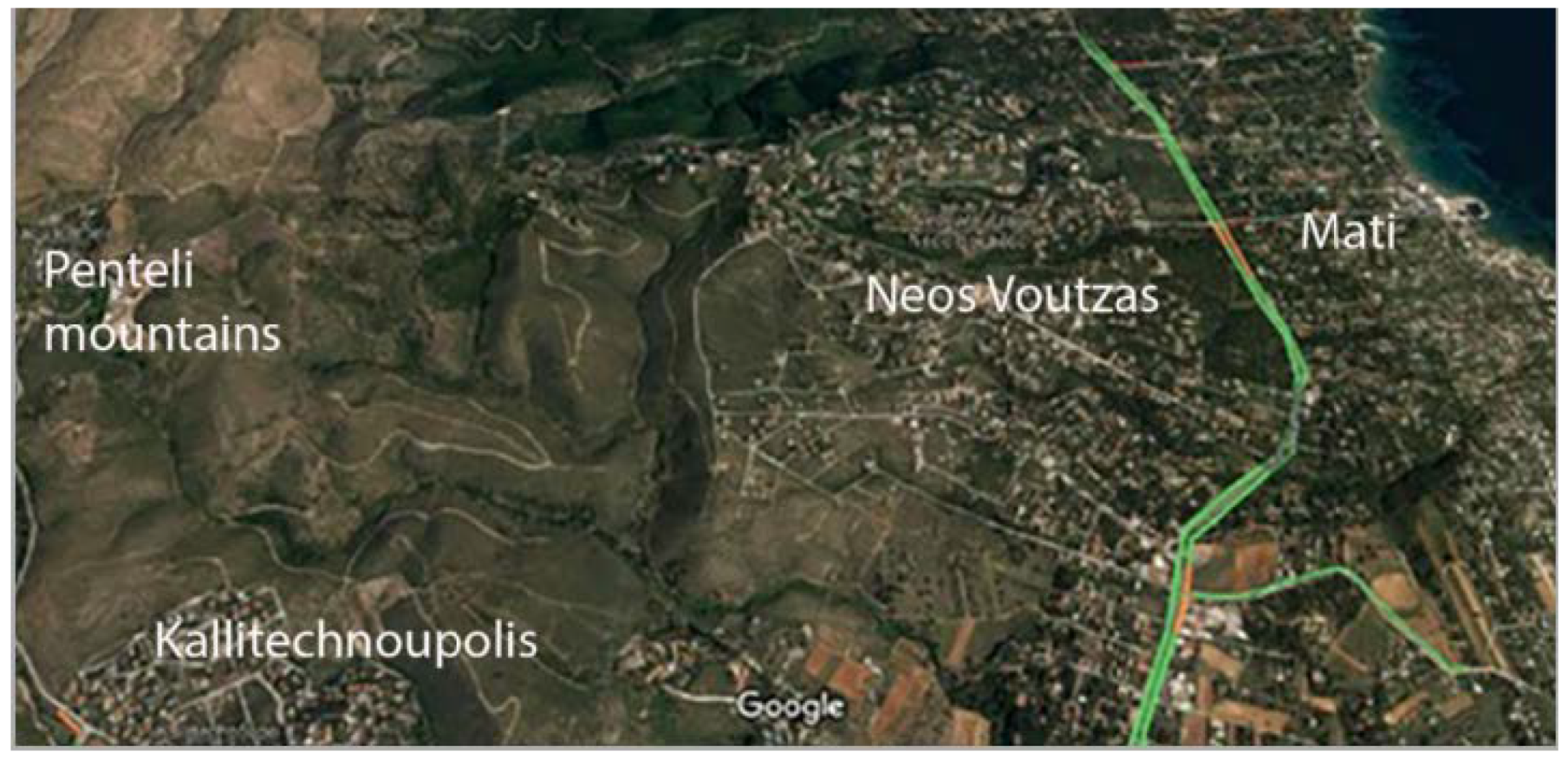
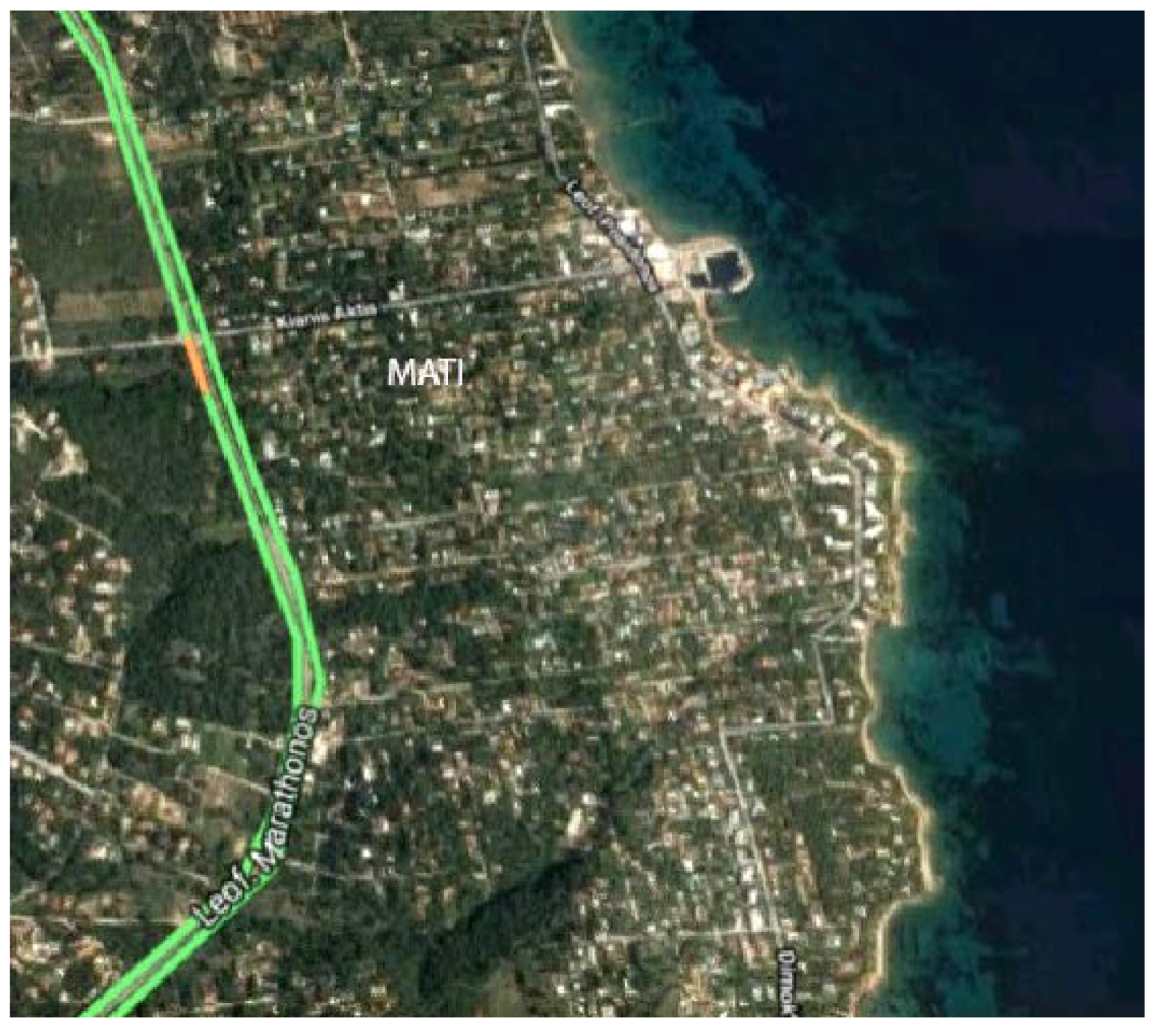
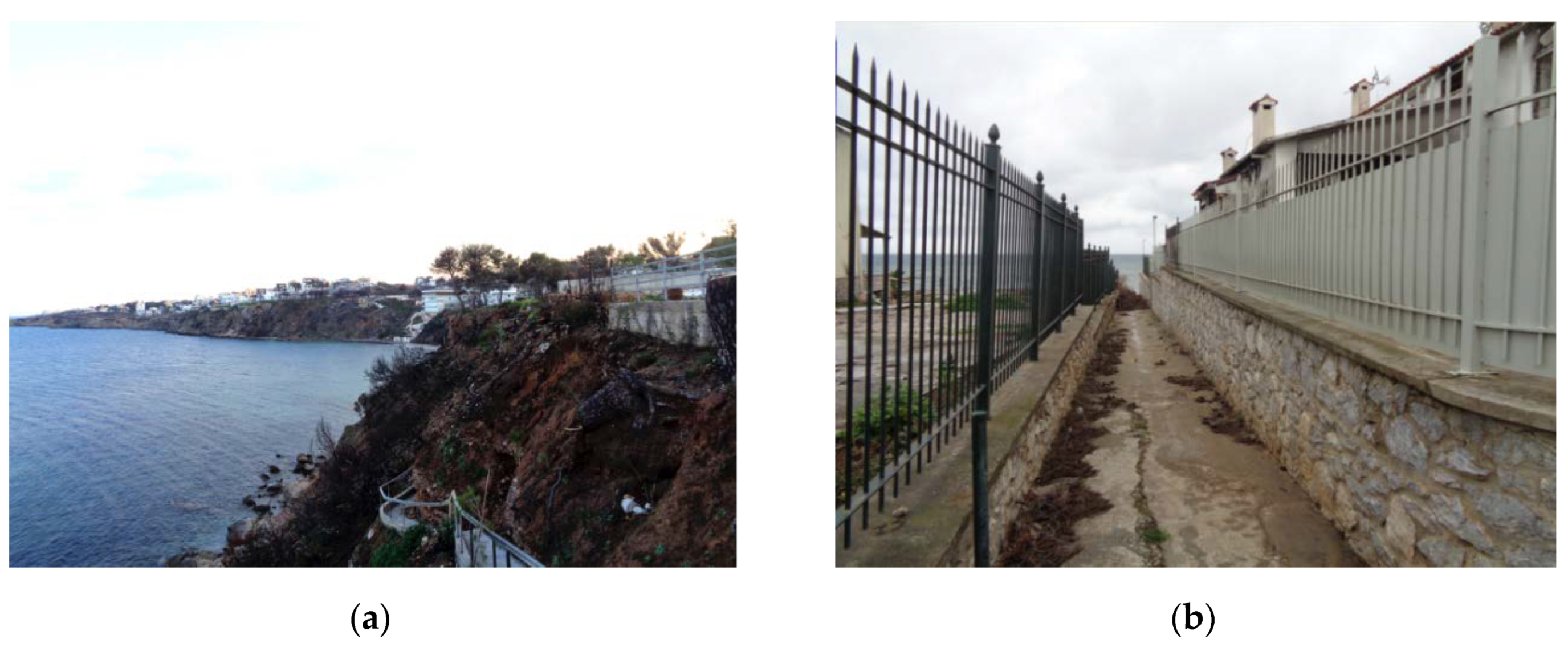
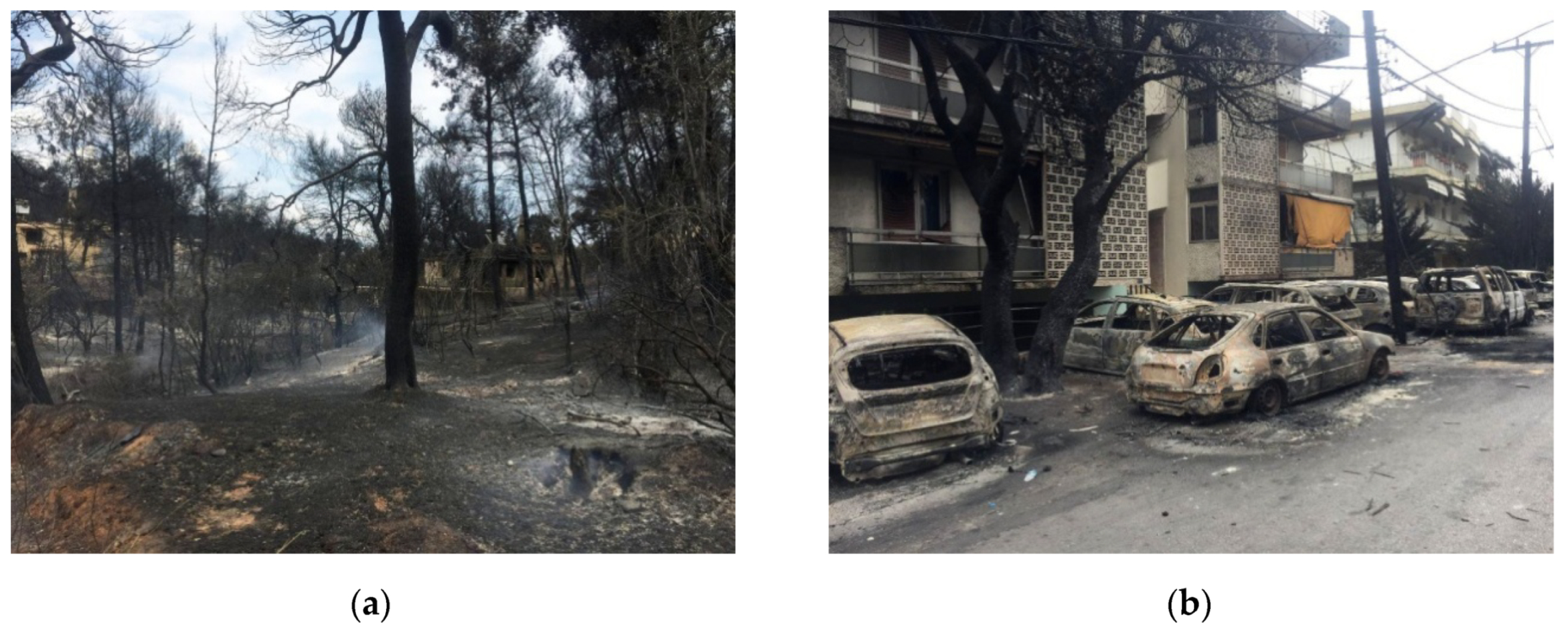
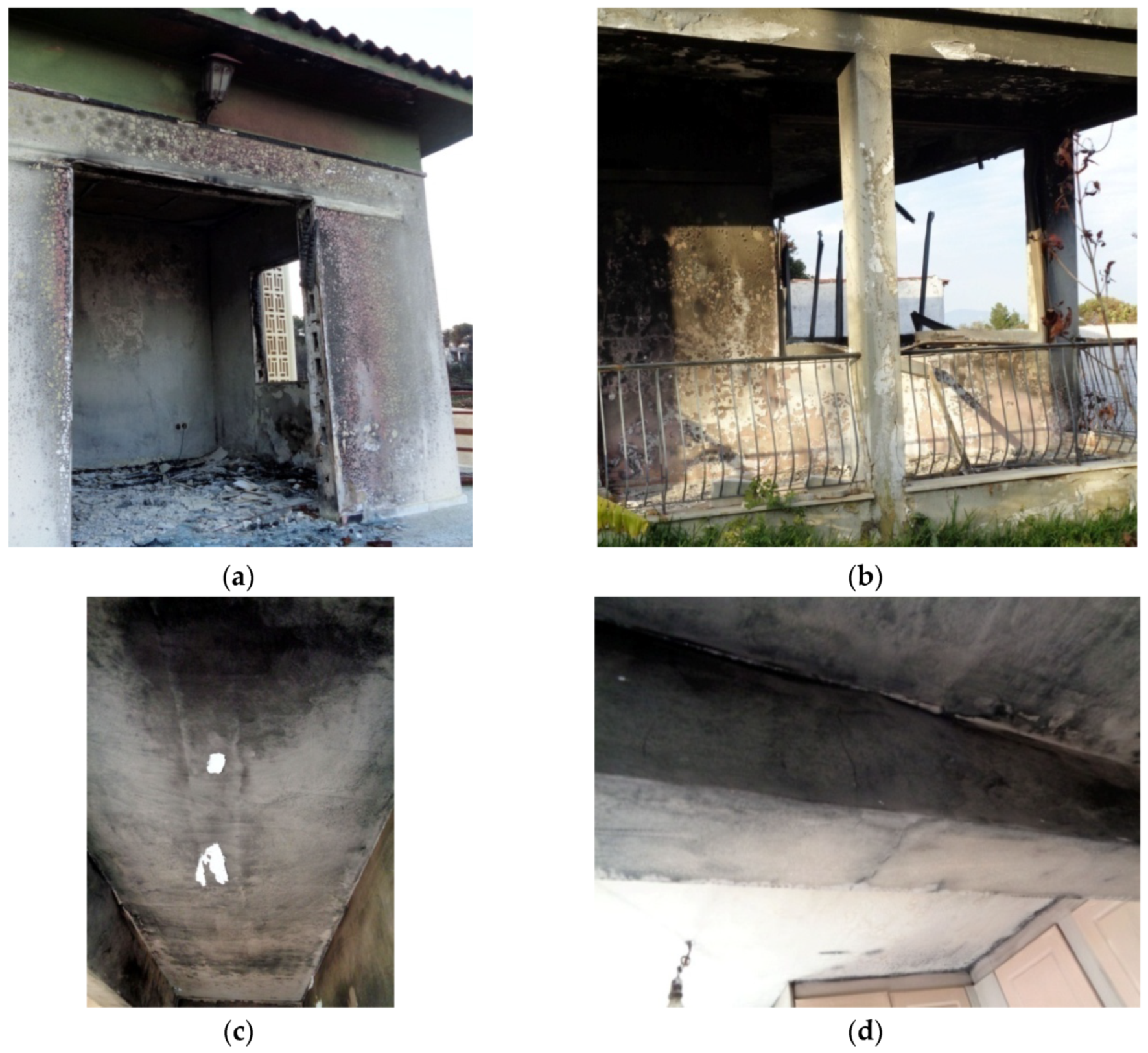
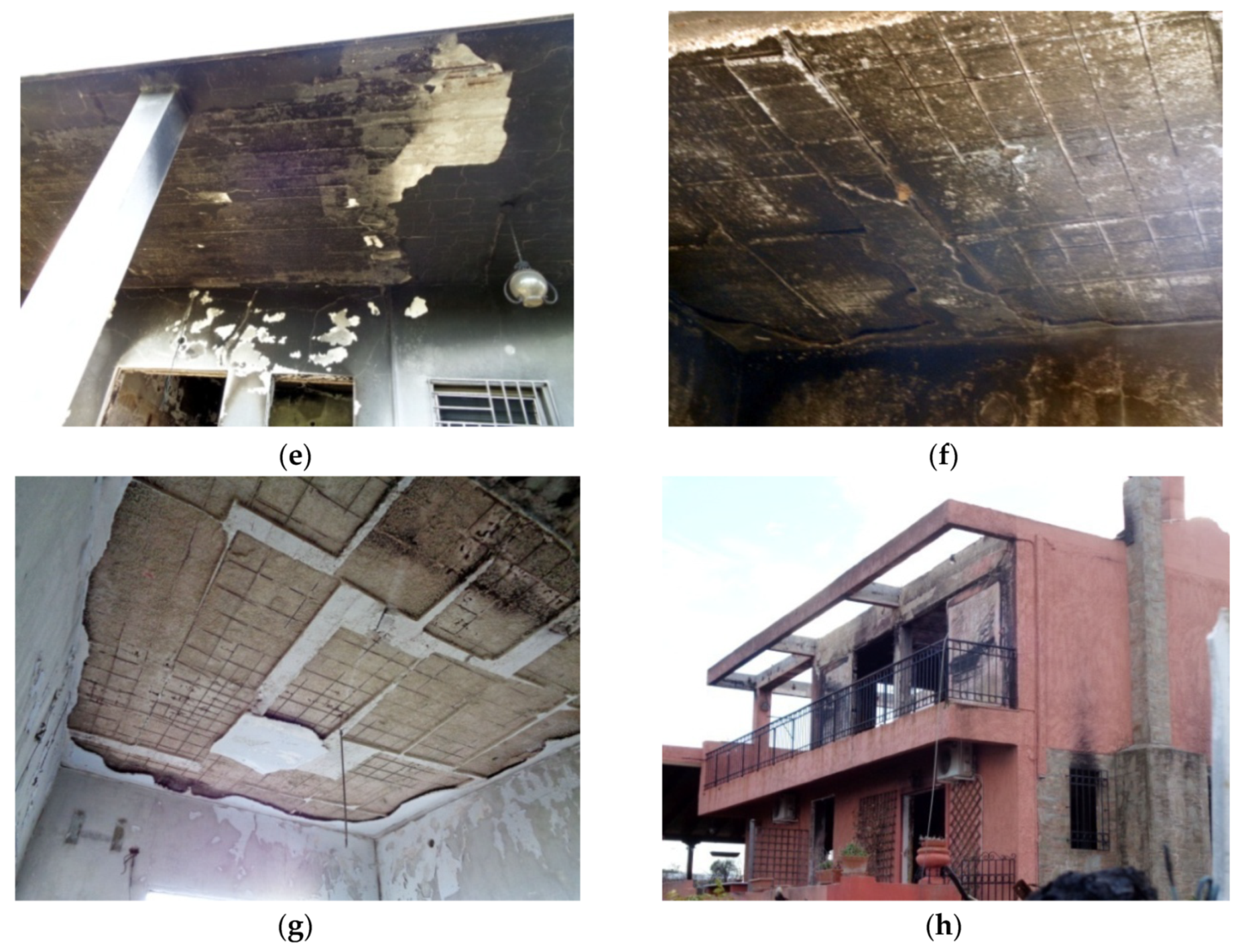
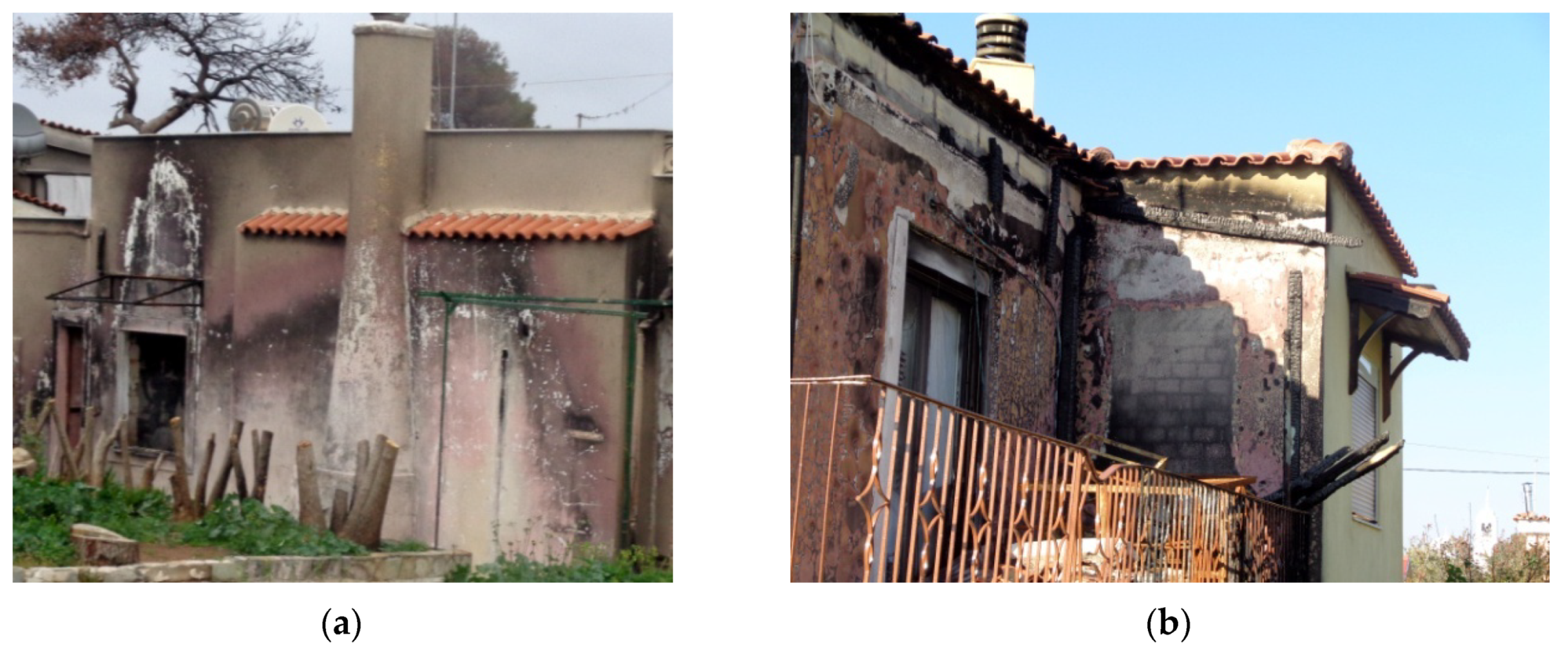
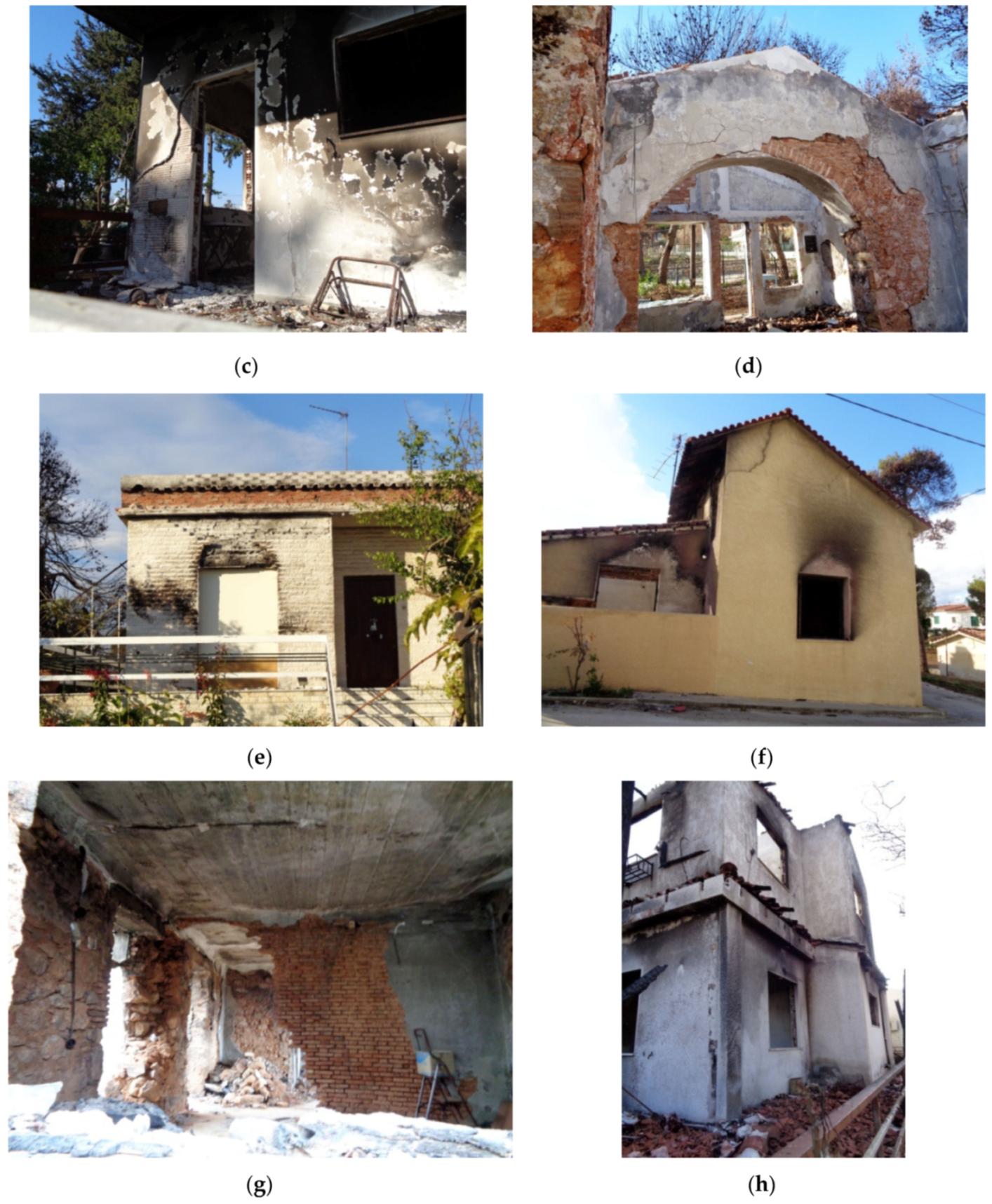
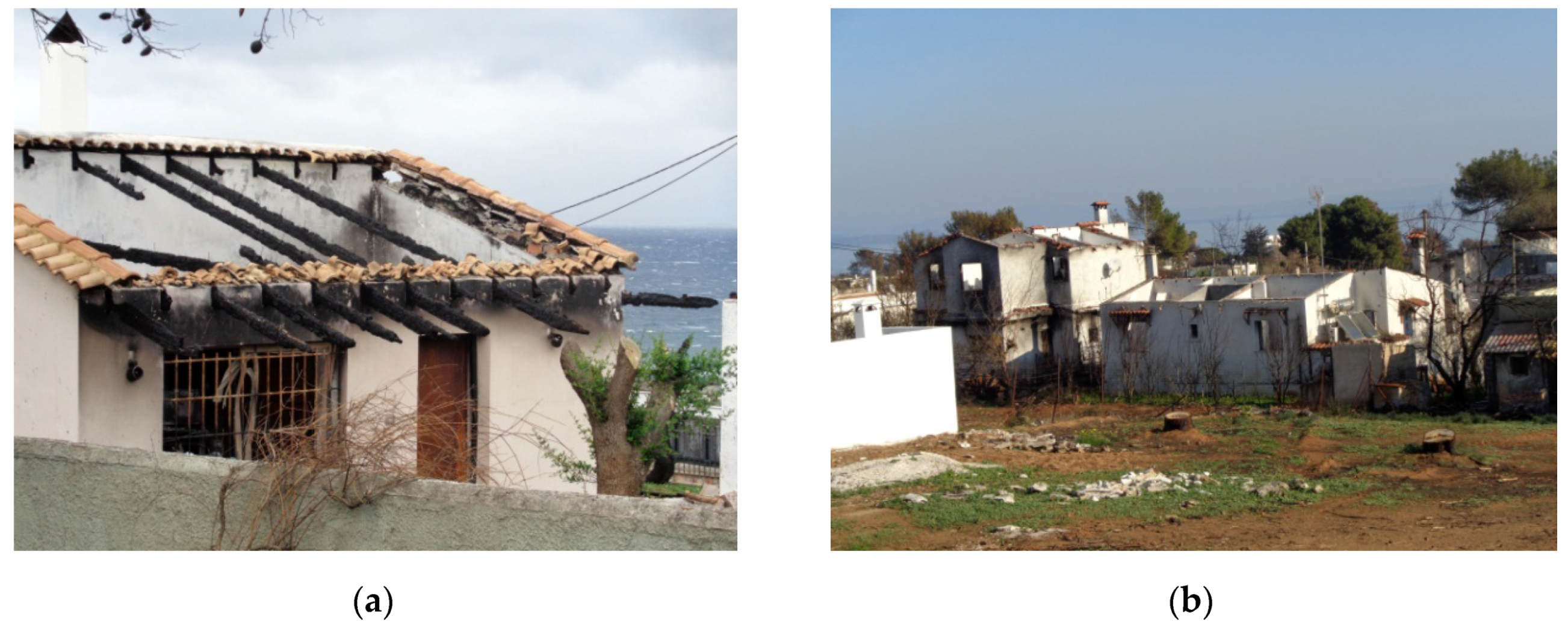
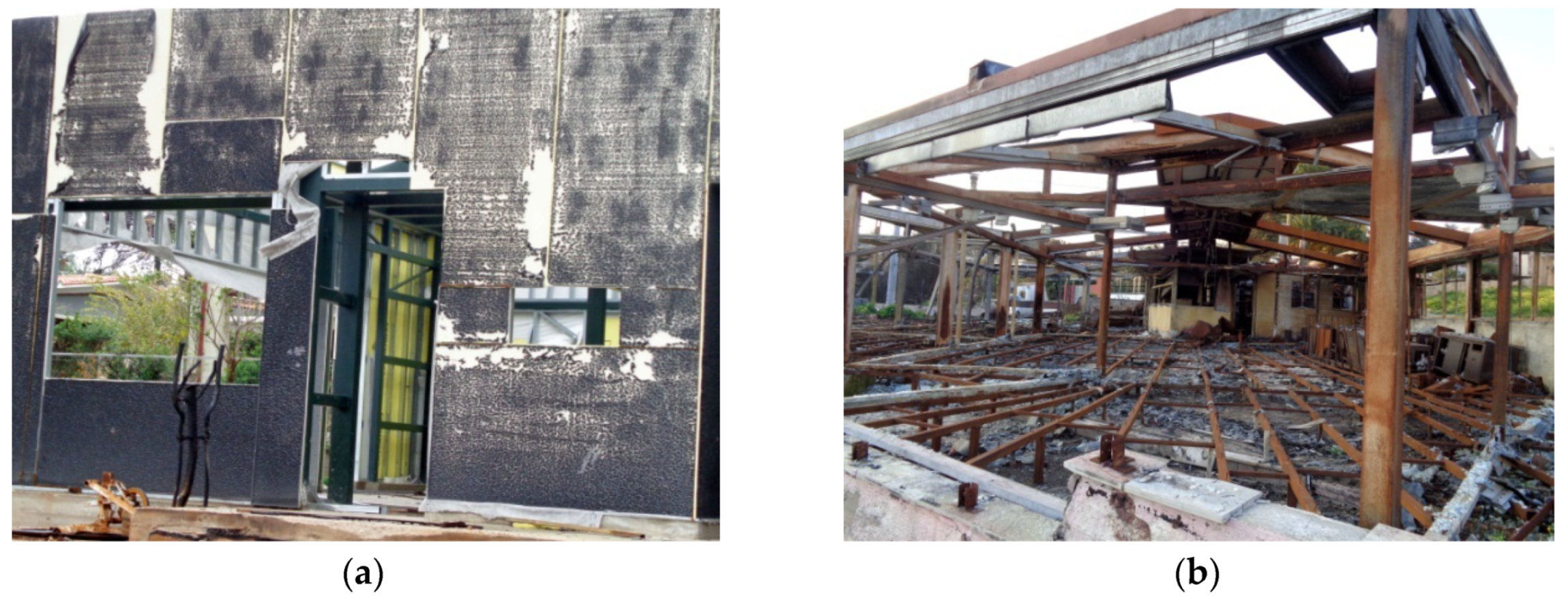
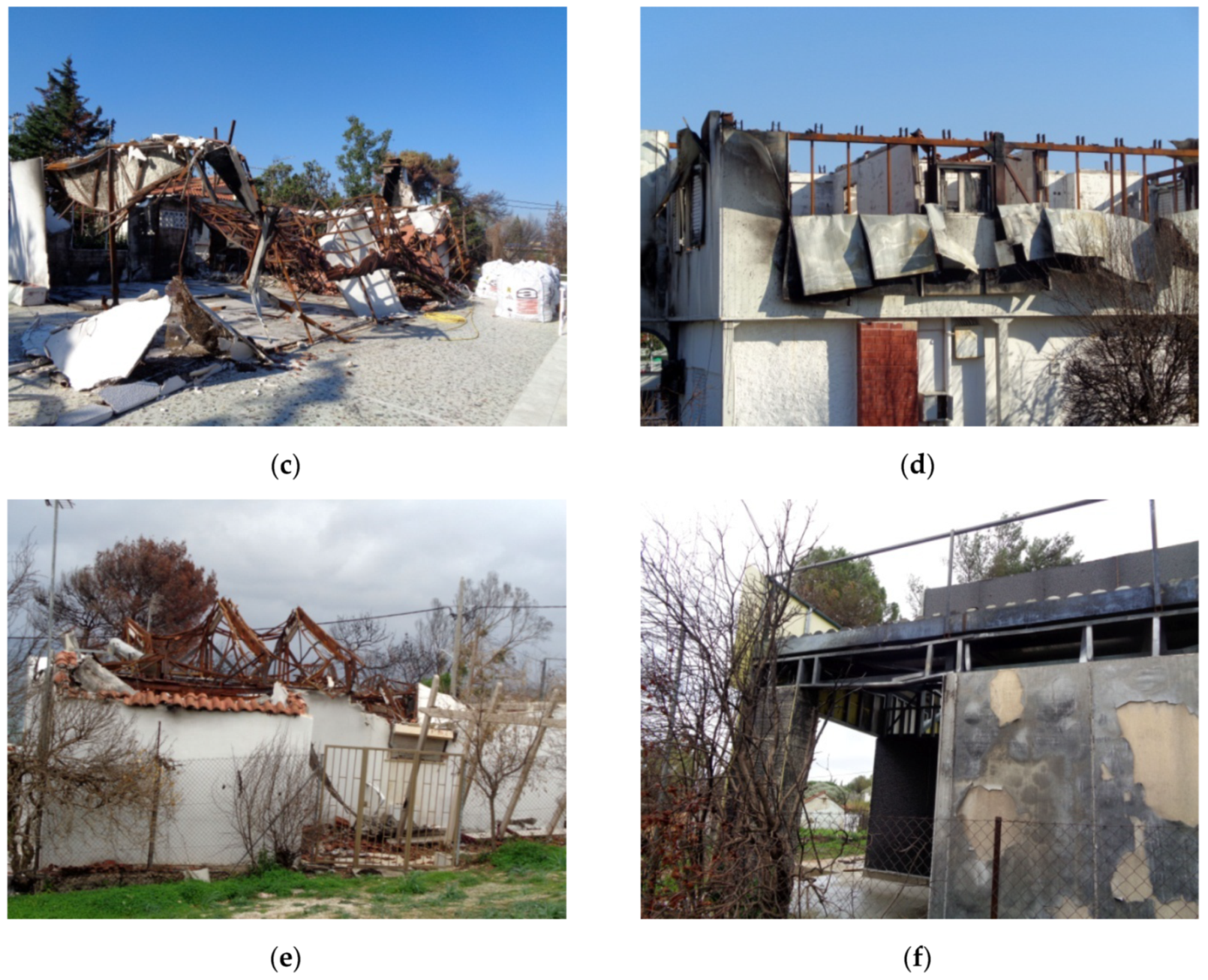
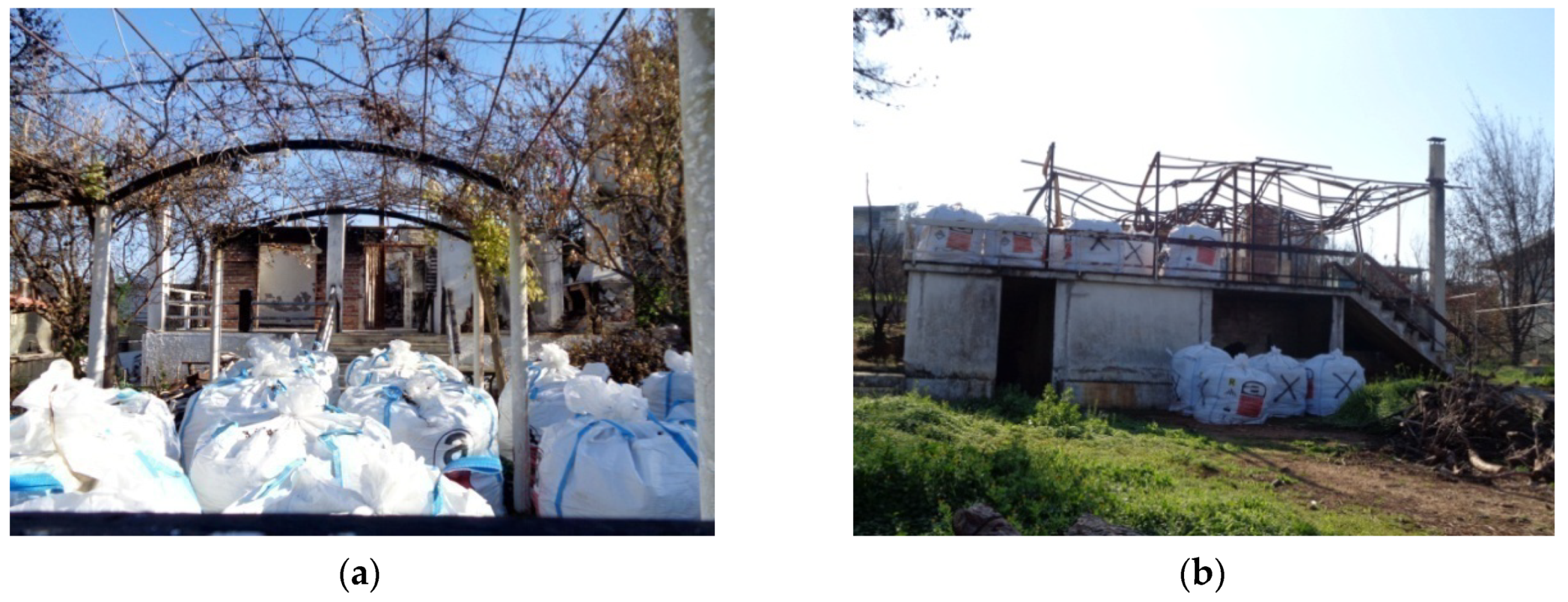
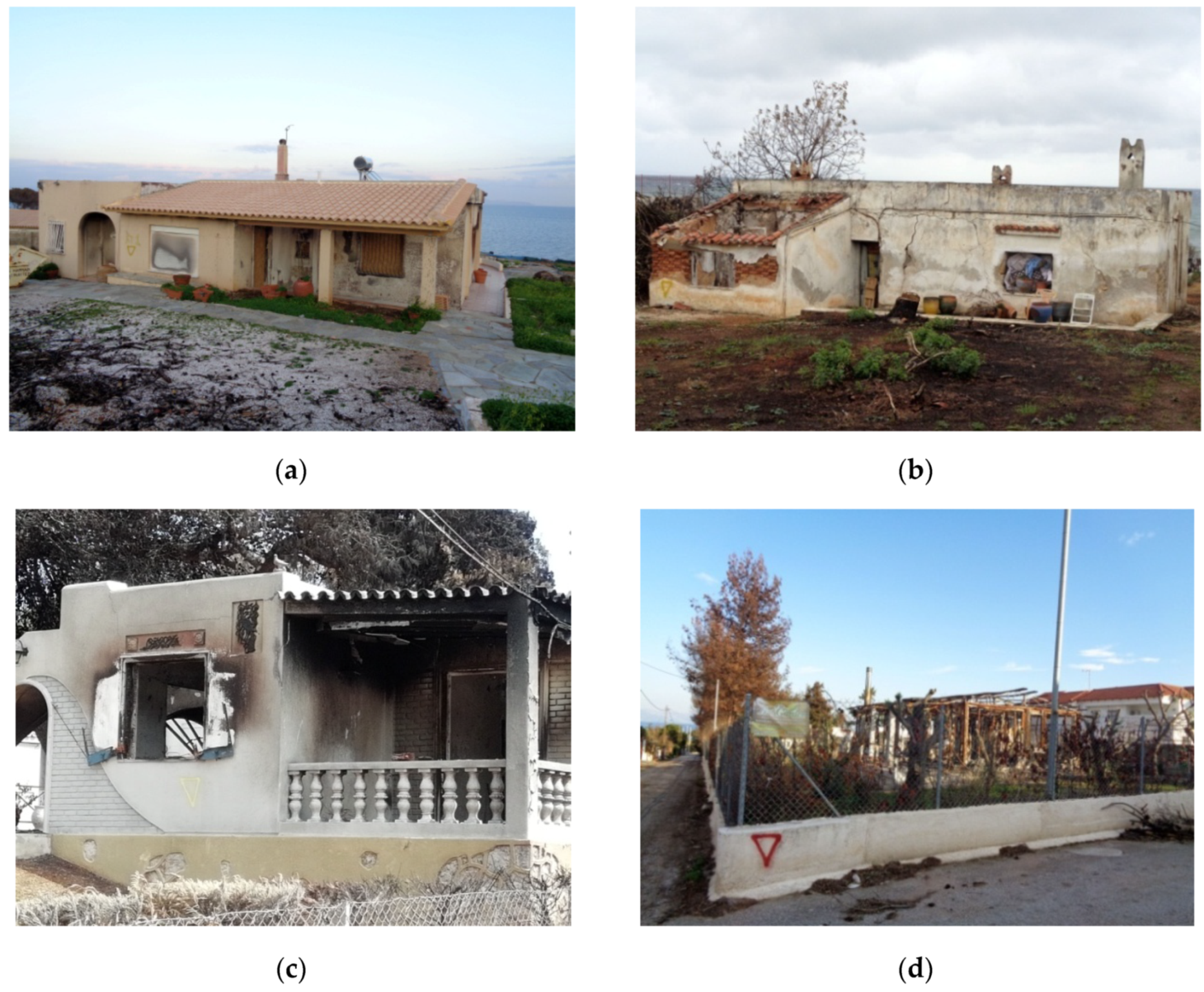
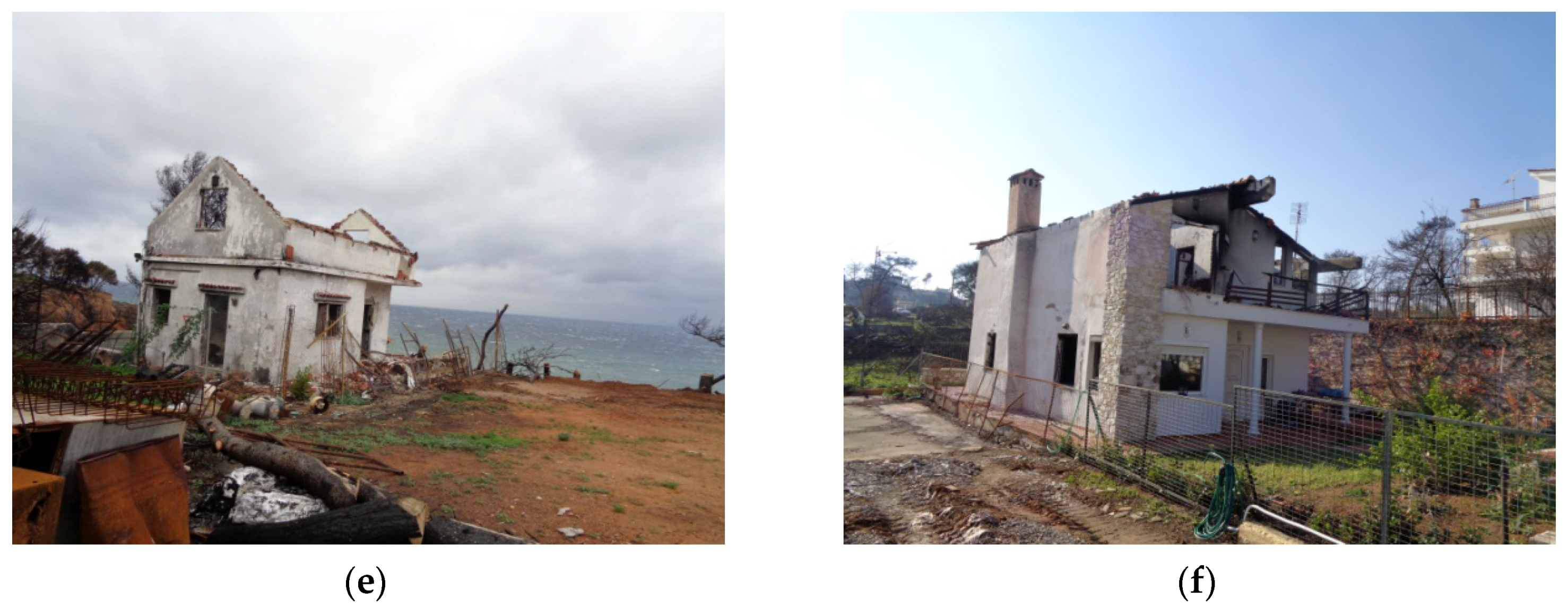
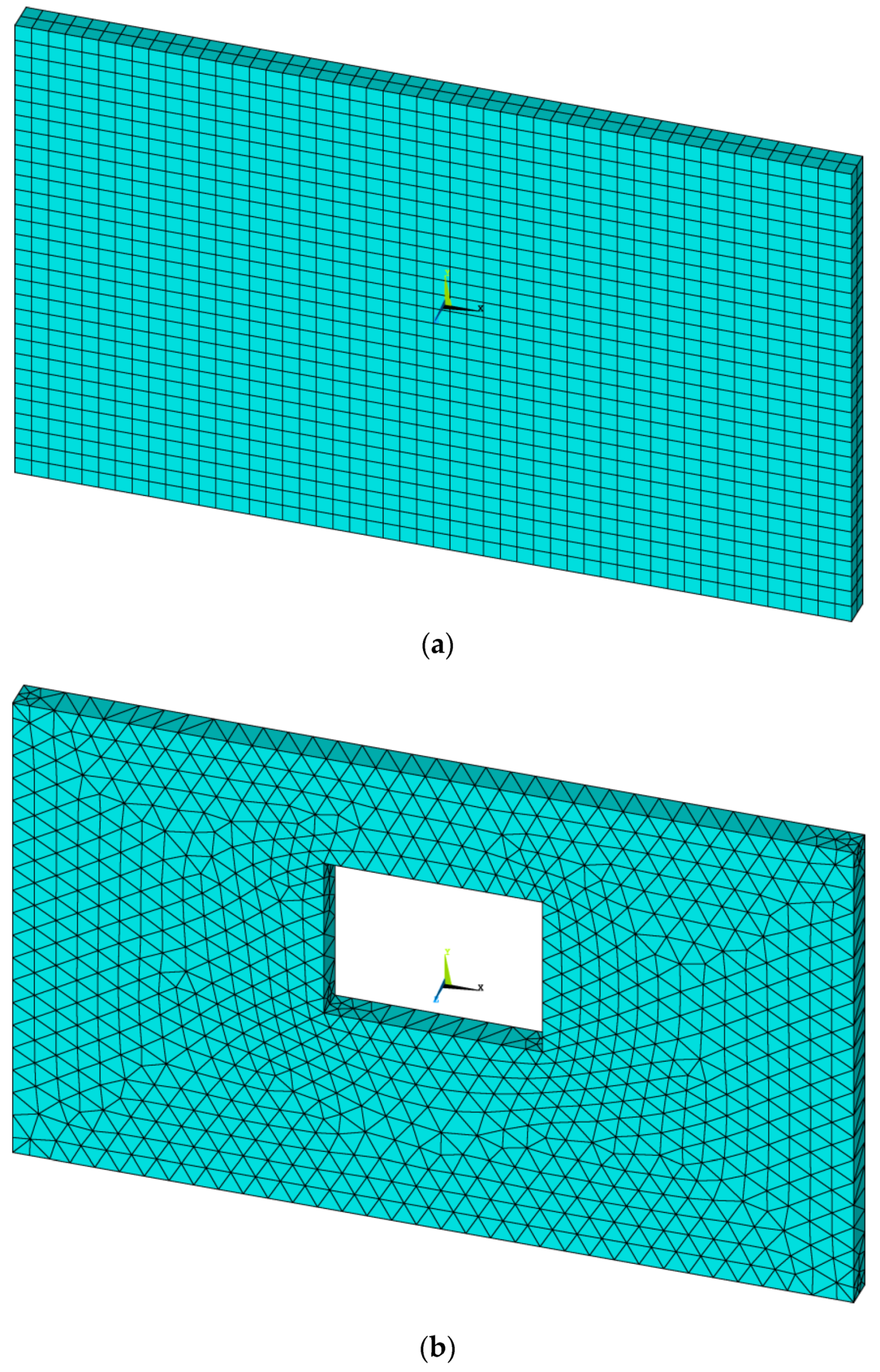
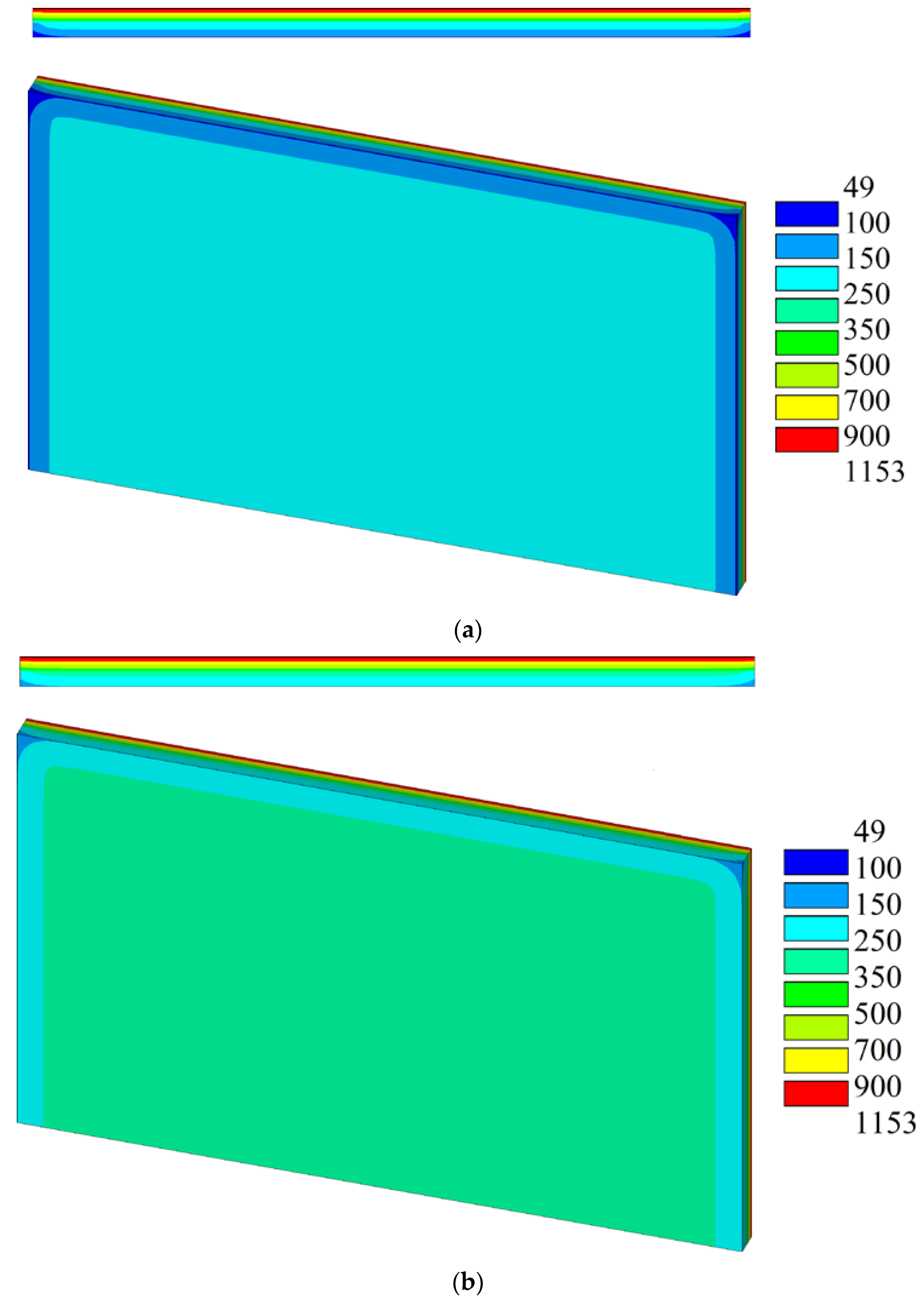
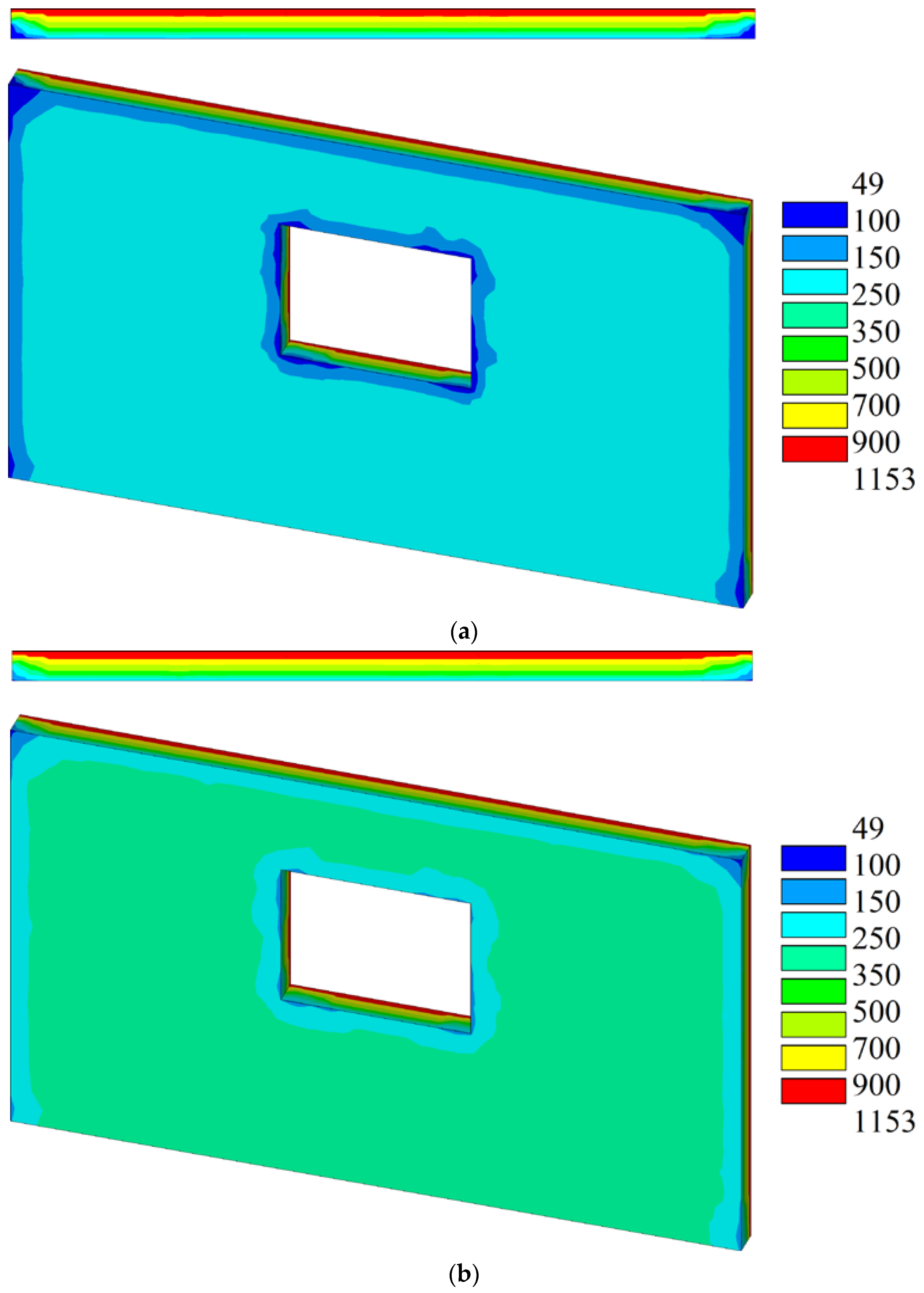
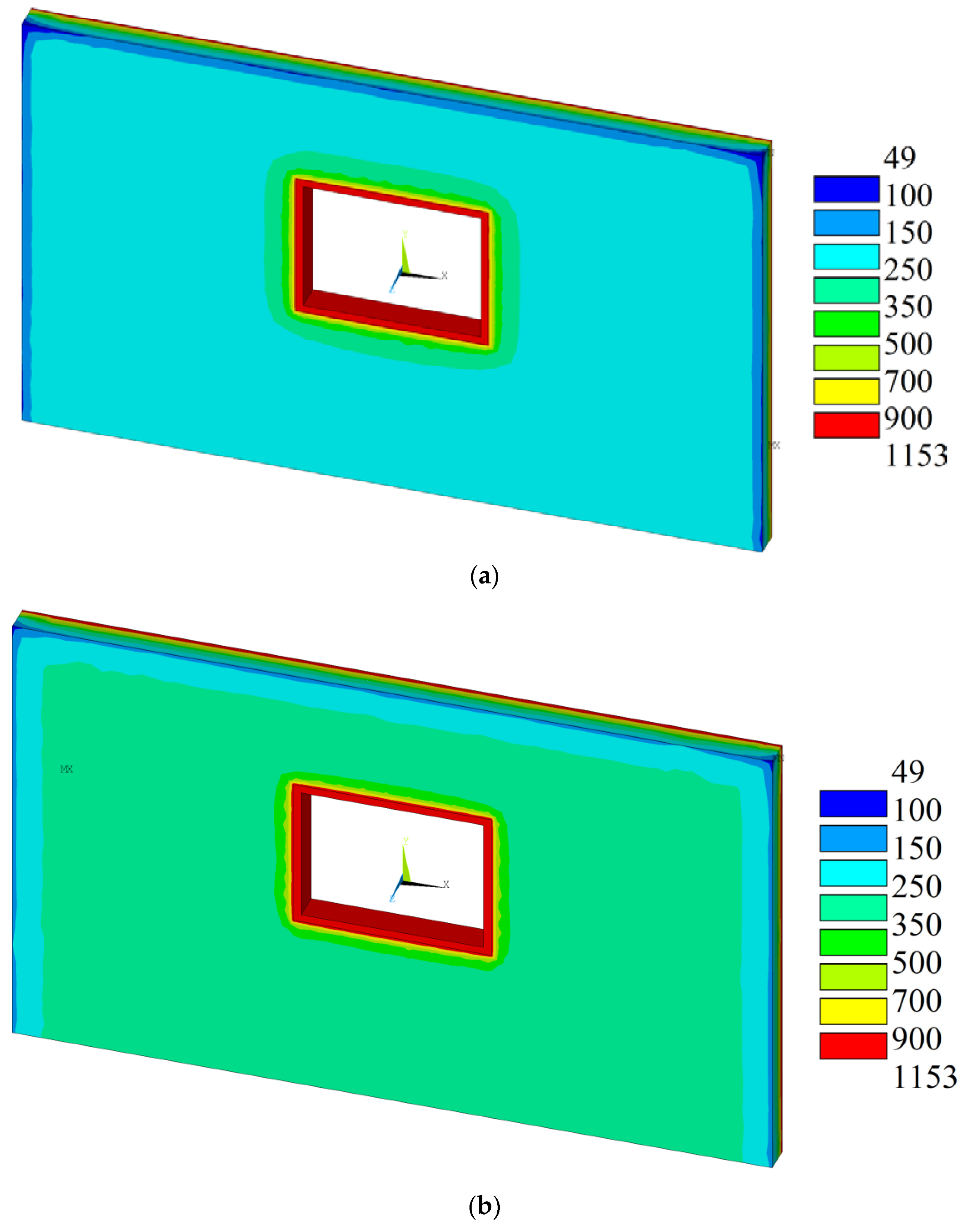
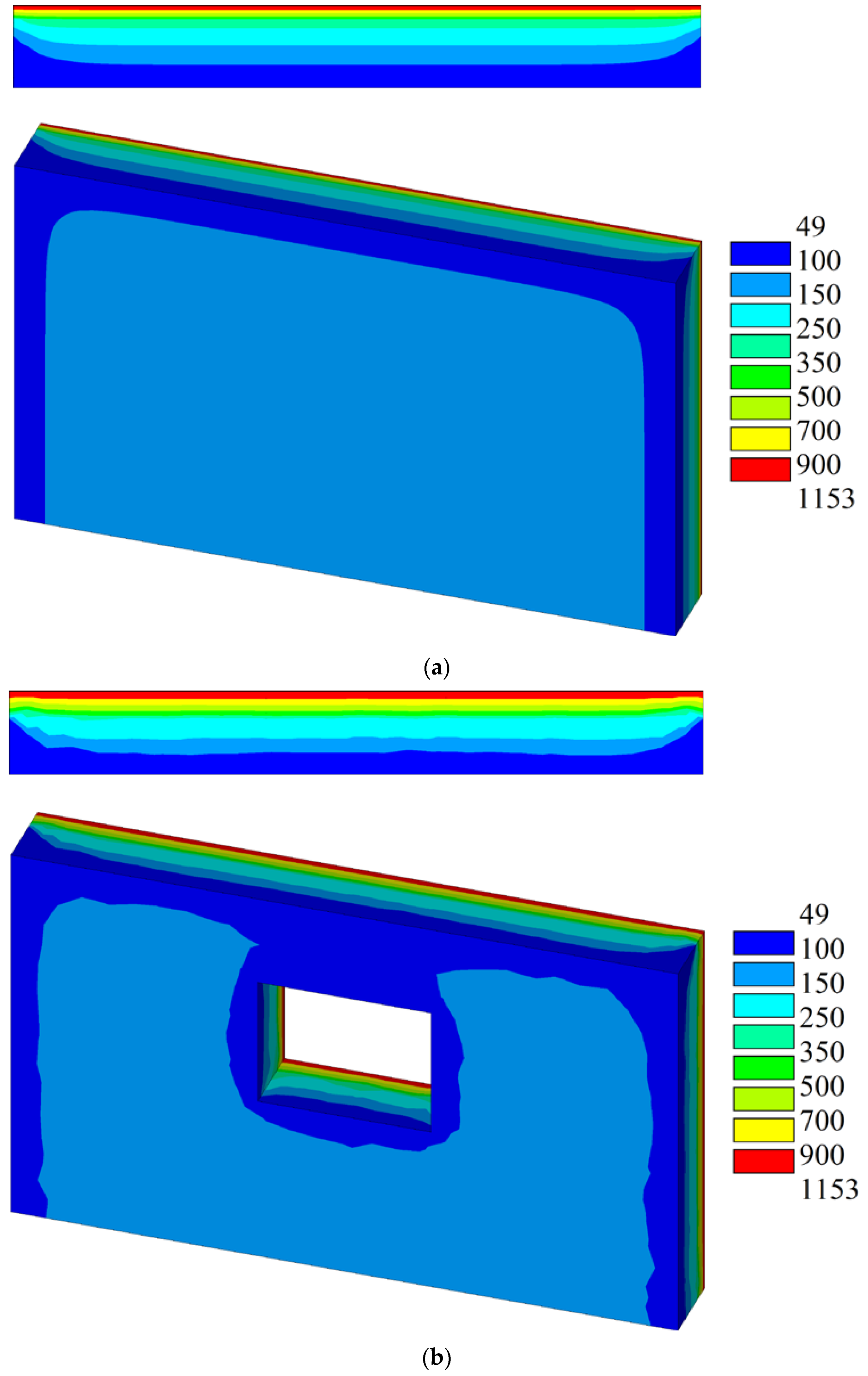
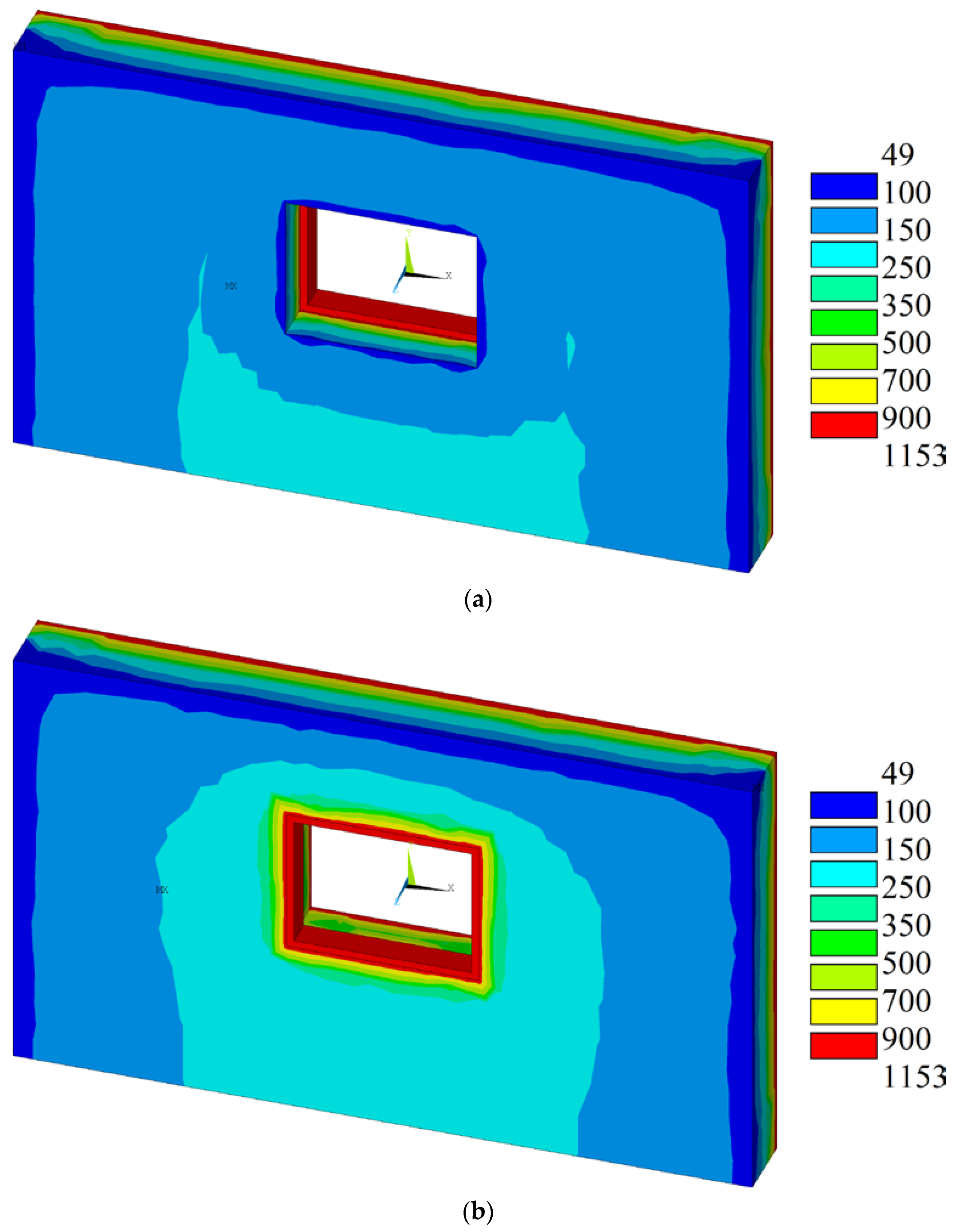
© 2019 by the authors. Licensee MDPI, Basel, Switzerland. This article is an open access article distributed under the terms and conditions of the Creative Commons Attribution (CC BY) license (http://creativecommons.org/licenses/by/4.0/).
Share and Cite
Papalou, A.; Baros, D.K. Assessing Structural Damage after a Severe Wildfire: A Case Study. Buildings 2019, 9, 171. https://doi.org/10.3390/buildings9070171
Papalou A, Baros DK. Assessing Structural Damage after a Severe Wildfire: A Case Study. Buildings. 2019; 9(7):171. https://doi.org/10.3390/buildings9070171
Chicago/Turabian StylePapalou, Angeliki, and Dimitrios K. Baros. 2019. "Assessing Structural Damage after a Severe Wildfire: A Case Study" Buildings 9, no. 7: 171. https://doi.org/10.3390/buildings9070171
APA StylePapalou, A., & Baros, D. K. (2019). Assessing Structural Damage after a Severe Wildfire: A Case Study. Buildings, 9(7), 171. https://doi.org/10.3390/buildings9070171



